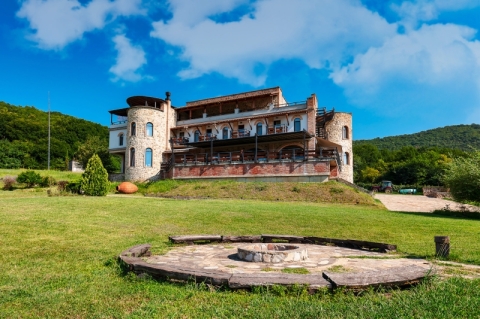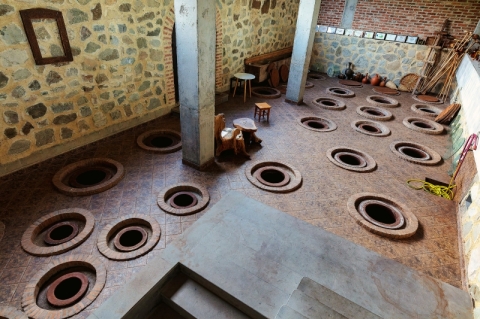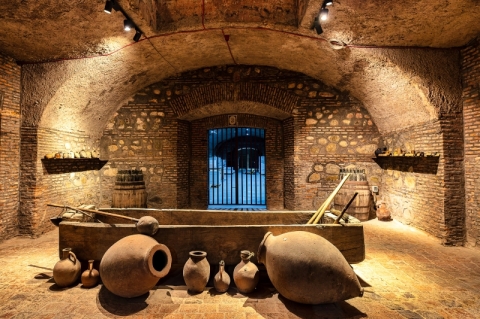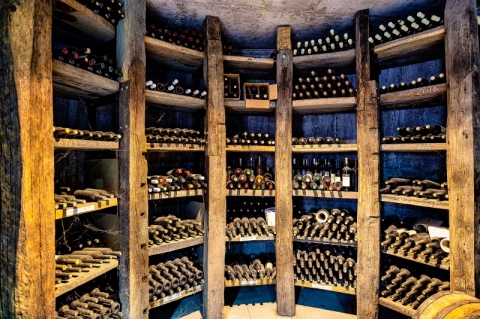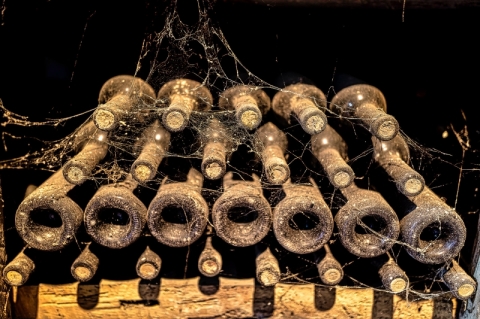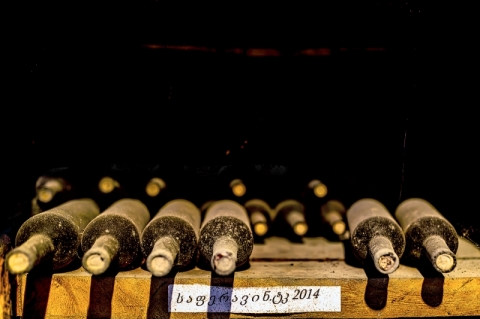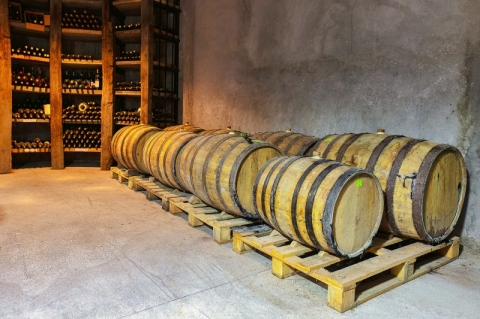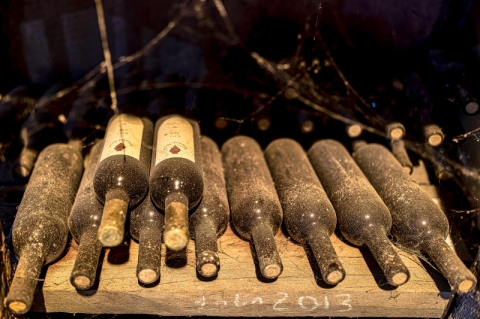Reisen
Babaneuris Marani Akhmeta Georgia
Georgian Wine: A Millennial Journey

Georgian Wine, cellar Babaneuris Marani Akhmeta Ge (Quelle: Roberto Magni Daniela Comi By Foto ReD Photographi)
GDN -
During our visit to Georgian wineries, we chose to talk about the Babaneuris Marani company, located in Akhmeta, in the Kakheti region, because in our opinion, it produces the best wines in all of Georgia.
The company is situated in a magical environment with breathtaking views of the vineyards. This Boutique Hotel offers an enchanting setting with views of its vineyards and is managed by the family itself, who are always ready to introduce you to the traditions, wines, and delicious food in a magical environment wrapped in relaxing silence.
The company is situated in a magical environment with breathtaking views of the vineyards. This Boutique Hotel offers an enchanting setting with views of its vineyards and is managed by the family itself, who are always ready to introduce you to the traditions, wines, and delicious food in a magical environment wrapped in relaxing silence.
The structure also includes an excellent restaurant that serves very refined classic Georgian cuisine, meticulously curated in detail and composition, using the freshest organic products of local origin.
All the vineyards, the winery, and the boutique hotel are located at the foot of the greater caucasus mountain range with a picturesque view of the main historical and cultural sites of the region.
This company has 11 hectares of land perfectly suited for wine cultivation, all adjacent to the property, positioned in an optimal sunny location to obtain a product of the highest quality.
Babaneuris Marani produces wines with four Georgian grape varieties: Saperavi, Mtsvane, Kisi, and Rkatsiteli. These excellent wines are produced in Qvevris, the traditional terracotta amphoras buried in the cool earth.
HISTORY AND TRADITION OF GEORGIAN WINE IN TERRACOTTA AMPHORAS:
Georgia, a nation located at the crossroads of Europe and Asia, is known not only for its natural beauty and rich culture but also for one of the oldest winemaking traditions in the world.
Georgia primarily cultivates many indigenous grape varieties that are unknown in our latitudes. One of the most important regions is Kakheti. Part of the production is also dedicated to the production of sparkling wines and grappas. However, this winemaking method is making waves in Western Europe, and these wines are also referred to as “orange wine” or “amphora wine” due to their dark and oxidative coloration.
Today, these wines are making a big splash in starred restaurants. Excellent chefs have skillfully paired them with incredible dishes.
The origins of winemaking in Georgia intertwine with the history of humanity itself. It is estimated that ancient Georgians began cultivating vines and producing wine around 6000 BC. Archaeological excavations have revealed ancient winemaking tools, grape seeds, and Qvevri, providing tangible evidence of the winemaking practices of the time. This South Caucasus country is considered the “Cradle of Wine” and has developed a unique method of wine production, which has been recognized by UNESCO as an intangible cultural heritage of humanity.
The earliest evidence of winemaking in Georgia dates back to the 6th millennium BC, with the discovery of grape seeds and ceramic fragments containing traces of wine. These archaeological findings demonstrate that Georgia has one of the oldest winemaking traditions in the world.
During the Soviet period, Georgian wine production suffered a severe blow due to the demand for large quantities of low-cost wine. However, in recent decades, there has been a revival of traditional techniques, with a renewed interest in quality and authenticity.
THE TRADITIONAL METHOD:
The heart of Georgian winemaking is the Qvevri, a large terracotta amphora buried to ensure stable fermentation temperatures. This method is used for both white and red wines and follows these steps:
HARVESTING THE GRAPES: The grapes are hand-picked and carefully selected.
CRUSHING:
The grapes are crushed, and the must, along with the skins, seeds, and stems, is poured into the Qvevri.
FERMENTATION:
The Qvevri are sealed with a wooden lid, allowing fermentation to occur in a natural environment for several weeks. During this period, the must transforms into wine thanks to the action of natural yeasts present on the grape skins.
MATURATION:
After fermentation, the wine is left to mature in the Qvevri for several months, sometimes even years. This process gives Georgian wine its characteristic tannic flavor and aromatic complexity.
PRESERVATION AND TRADITION:
The terracotta amphoras, known as Qvevri, are handmade by local artisans and coated internally with beeswax to prevent wine contamination. They are a distinctive element of Georgian winemaking. These amphoras, which can reach considerable sizes, are buried in the ground and used to ferment, store, and age wine. Once filled, they are buried up to the neck, ensuring a constant temperature throughout the year. This preservation method allows the wine to develop a unique and complex aromatic profile. The use of Qvevri is not just a winemaking technique but also represents a deep connection with the land and ancestral traditions. The shape and material of the amphoras allow for natural fermentation, creating wines with unique and complex flavors.
AGING IN QVEVRI:
After fermentation, the wine remains in the Qvevri for several months or even years, allowing the flavors to develop and refine. This practice, known as “natural winemaking,” does not use chemical additives and strives to maintain the essence of the Georgian terroir. Each Qvevri has its own personality, influenced by the soil, climate, and grape variety used.
GEORGIAN WINE VARIETIES:
Georgia boasts over 500 grape varieties, but some of the most well-known include:
SAPERAVI: A dark, full-bodied, and tannic red wine with notes of berries and spices.
RKATSITELI: A white wine with high acidity and fruity and floral flavors.
KISI: A dry white wine with fruit and citrus aromas and a slightly spicy finish.
MTSVANE: The taste is typically fresh and crisp, with a bright acidity.
CULTURAL SIGNIFICANCE OF WINE IN GEORGIA:
In Georgia, wine is not just a beverage but a symbol of hospitality, friendship, and tradition. The wine culture is intrinsically linked to the celebration of important events, such as weddings and family gatherings. Georgians often practice a ritual called “tamada,” where a “tamada” (toastmaster) leads toasts and speeches during banquets.
CONCLUSION:
The history and tradition of Georgian wine in terracotta amphoras represent a cultural heritage and a deep connection to the land. The art of winemaking in Georgia continues to thrive, carrying forward a legacy that spans millennia. With growing international interest, Georgian wine is not just a beverage to enjoy but a link between the past and the future, a true ritual that unites tradition, culture, and community. Every bottle of Georgian wine tells a millennial story of passion, dedication, and love for the land, a celebration of vibrant and living traditions.
Visitors to Georgia should not miss the opportunity to explore this unique culture, savoring wines that tell the stories of a civilization that has embraced viticulture as an integral part of its identity.
Info Babaneuris Marani Akhmeta Georgia
www.babaneuri.com
info@babaneuri.com
weitere Informationen: https://www.redmagazine.red
Für den Artikel ist der Verfasser verantwortlich, dem auch das Urheberrecht obliegt. Redaktionelle Inhalte von GDN können auf anderen Webseiten zitiert werden, wenn das Zitat maximal 5% des Gesamt-Textes ausmacht, als solches gekennzeichnet ist und die Quelle benannt (verlinkt) wird.

